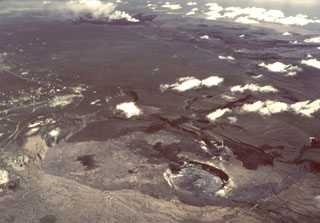Report on Kilauea (United States) — 17 November-23 November 2010
Smithsonian Institution / US Geological Survey
Weekly Volcanic Activity Report, 17 November-23 November 2010
Managing Editor: Sally Sennert.
Please cite this report as:
Global Volcanism Program, 2010. Report on Kilauea (United States) (Sennert, S, ed.). Weekly Volcanic Activity Report, 17 November-23 November 2010. Smithsonian Institution and US Geological Survey.
Kilauea
United States
19.421°N, 155.287°W; summit elev. 1222 m
All times are local (unless otherwise noted)
During 17-23 November, HVO reported that activity at Kilauea continued from the summit caldera and the east rift zone. At the summit caldera, the level of the lava-pool surface in the deep pit within Halema'uma'u crater remained mostly stable approximately 150 m below the crater floor, periodically rising about 20 m above that level. Nighttime incandescence has been visible from the Jaggar Museum on the NW caldera rim since early 2010. A plume from the vent deposited ash nearby.
At the east rift zone, lava continued to flow through the TEB lava-tube system and fed small weakly active surface flows on the coastal plain, breakout flows W of a county viewing area (located along Highway 130), and a single ocean entry on the Puhi-o-Kalaikini delta W of Kalapana Gardens subdivision. Incandescence was visible from vents on the N part of the Pu'u 'O'o crater floor during 17-18 November. Spattering from the vent was seen during 18-19 November, and a slow-moving lava flow began at about noon on 19 November.
Geological Summary. Kilauea overlaps the E flank of the massive Mauna Loa shield volcano in the island of Hawaii. Eruptions are prominent in Polynesian legends; written documentation since 1820 records frequent summit and flank lava flow eruptions interspersed with periods of long-term lava lake activity at Halemaumau crater in the summit caldera until 1924. The 3 x 5 km caldera was formed in several stages about 1,500 years ago and during the 18th century; eruptions have also originated from the lengthy East and Southwest rift zones, which extend to the ocean in both directions. About 90% of the surface of the basaltic shield volcano is formed of lava flows less than about 1,100 years old; 70% of the surface is younger than 600 years. The long-term eruption from the East rift zone between 1983 and 2018 produced lava flows covering more than 100 km2, destroyed hundreds of houses, and added new coastline.
Source: US Geological Survey Hawaiian Volcano Observatory (HVO)

